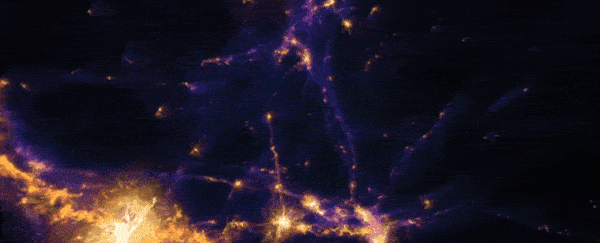Saying our Universe is a big place is a bit of an understatement. And with recent advances in our understanding of the effects of dark matter and black holes on the formation of galaxies, it's surprisingly dynamic.
Keeping track of all of that material requires some impressive computing grunt and clever coding, which is just what astrophysicists now have thanks to this latest simulation model.
Already it's making some pretty accurate predictions, promising insights that no doubt will lead to a bunch of exciting discoveries.
Titled Illustris: The Next Generation (or IllustrisTNG for short), it's clear that the simulation is expected to expand the frontiers of space discovery.
"When we observe galaxies using a telescope, we can only measure certain quantities," says astrophysicist Shy Genel from the Flatiron Institute's Center for Computational Astrophysics (CCA).
"With the simulation, we can track all the properties for all these galaxies. And not just how the galaxy looks now, but its entire formation history."
IllustrisTNG is the successor to Illustris, and based on the contributions of researchers from CCA, MIT, Harvard University, University of Cambridge, Heidelberg Institute of Theoretical Studies, and the Institute for Advanced Study.
In effect, TNG actually consists of 18 simulations covering various scales - each a cubic mock-up of space up to 1 billion light years wide - tracing the evolution of the Universe from just after the Big Bang into the future.
With more resolution and new physics, the improved simulations not only cover more ground, they can now accurately model the patterns of clustering galaxies, and how this web shifts over time.
Keeping track of a billion square light years of galactic material, magnetic fields, and dark matter requires some impressive hardware.
So the project uses Germany's fastest supercomputer, the Hazel Hen, to crunch the numbers.
It still took two months to run through the calculations for just one of the larger simulations, amassing 500 terabytes of data.
That said, it's a lot quicker than waiting for a Universe to grow.
"Analysing this huge mountain of data will keep us busy for years to come, and it promises many exciting new insights into different astrophysical processes," says Volker Springel from the Heidelberg Institute for Theoretical Studies.
The level of accuracy being achieved so far is exciting. Already, three papers have been published describing the large scale clustering of matter, helping us understand how galaxies form.
Of course, anything found in the simulations are simply flags that require closer inspection by astronomers.
One piece of research published in the Monthly Notices of the Royal Astronomical Society demonstrated the nature of faint haloes of stars that form as galaxies collide and merge; normally too faint to see, the simulation shows what signature to hunt for.
Another study explored the impact black holes have on star formation, adding much needed detail to models that suggest intense gravity wells at the centre of galaxies can drive winds that blow away star-forming gas and dust.
"It is particularly fascinating that we can accurately predict the influence of supermassive black holes on the distribution of matter out to large scales," says Springel.
"This is crucial for reliably interpreting forthcoming cosmological measurements."
Such discoveries will no doubt feed back into the models and fine tune them even further, promising further iterations to come.
It's exciting to imagine what secrets a third generation of Illustris might one day reveal.
